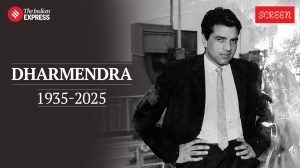The off screen story
He has the residence numbers of everyone from Amitabh Bachchan to Shah Rukh Khan on his finger tips. Rajendra Ojha, editor-publisher of the...

He has the residence numbers of everyone from Amitabh Bachchan to Shah Rukh Khan on his finger tips. Rajendra Ojha, editor-publisher of the Screen directory can give you a detailed resume of the who’s who of the film industry off the cuff. Or rather with a little bit of wrist action — he simply has to turn the pages of the film directory he created."What’s the big deal? It is not different from what the MTNL does," says Ojha. That statement is the only time Ojha is off the mark. Ask anyone remotely connected with the film world and they will tell you that the Screen directory is to them what the Lonely Planet is to travellers. It lists information about directors, actors, producers, technicians, props and even animal suppliers.
This compilation began when Ojha was a production manager with Rajshri Productions of Hum Aapke Hain Koun!! fame. His worksheet read like this: arrange vehicles, make-up men, paper cuttings and shooting locations. His only aide then — other than knocking on people’s doors — was a book from Calcutta, published once every four years.
In 1970, sparked off by a friend’s comment that he had enough information to publish a book, Ojha decided to record his information. Nine years in the making — accompanied by the additional responsibility of preparing censor-scripts’ as a script writer for films like Upahaar and Dharmatma — his own script was written purely by chance. "The first book happened in the most peculiar way. I dropped in at a printing press in the middle of a shoot and asked them to make a few copies. I picked up the book at the end of the day," says Ojha. So, in 1980, the first palm-sized pocket book edition of the Screen directory was born. Priced at Rs 7, it contained the names and phone numbers of few famous personalities of Bollywood.
Happy with the response, he published it again in 1982, adding information from the Madras and Gujarati film industry. But unfortunately this turned out to be a failure. "No one wanted to buy the book," says Ojha. The idea of adding addresses, along with phone numbers in the ’83 edition, served almost as a re-launch for the book. Earlier, when he had to go around asking people for numbers, he soon had people requesting him to add their names in the directory. "A famous producer who had asked me, Who is going to buy your directory when we have all the numbers?’, was the first to send his advertisements," says Ojha.
DD and satellite television also opened up new avenues for Ojha who used this opportunity to put together TV & Video Information — a user friendly guide to Doordarshan. The book provided comprehensive information on everything from statements showing DD rate structures to procedures for approval as well as guidelines for sponsored programmes.
But new technology brought with it incumbent problems. Says Ojha, "I would publish the book today and the very next day the numbers would change.
Earlier it used to take up to eight years for people to just get a new connection." Not one to be defeated, he introduced the system of providing free supplements to subscribers, informing them about changes in numbers, addresses and new connections.
Tired of limiting his horizons, he also released 75 Glorious Years of Indian Cinema in 1988, and 80 Glorious Years of Cinema in 1994, giving complete filmographies of all films produced between 1913 to 1993. But his only takers were people who produced film-based programmes. Disappointed, Ojha turned back to his directory and added the numbers and addresses of equipment rentals, new studios and music companies.
From a small Rs 7 pocket-sized book, the Screen directory has grown into a large Rs 2,000 hardbound book. Initially called the Film Pocket Guide, Ojha changed the name in the third edition to Screen. "It was not original, I named it after the Screen magazine — an Indian Express publication — which was very popular," he admits.
Ojha takes care of the marketing aspect himself and the books are not available on the stands. He even works from home roping in family members and assisted by his much-loved computer. Next on his publishing list: a book on award-winning artists.
Whether there are any takers for that book is not clear. What does ring a bell is the fact that his USP is clear: all a film-maker needs to produce a movie is lots of money, Hollywood-cogged script, a telephone and a copy of the Screen directory.



- 01
- 02
- 03
- 04
- 05




























